
About UsThe Numismatic Bibliomania Society is a non-profit organization promoting numismatic literature. For more information please see our web site at coinbooks.org SubscriptionsThose wishing to become new E-Sylum subscribers (or wishing to Unsubscribe) can go to the following web page link MembershipThere is a membership application available on the web site Membership Application To join, print the application and return it with your check to the address printed on the application. Membership is only $15 to addresses in the U.S., $20 for First Class mail, and $25 elsewhere. For those without web access, write to: David M. Sundman, Secretary/TreasurerNumismatic Bibliomania
Society AsylumFor Asylum mailing address changes and other membership questions, contact David at this email address: dsundman@LittletonCoin.com SubmissionsTo submit items for publication in The E-Sylum, just Reply to this message, or write to the Editor at this address: whomren@coinlibrary.com
BUY THE BOOK BEFORE THE COINYou won't regret it! |
- WAYNE'S WORDS: THE E-SYLUM FEBRUARY 27, 2011
- NEW BOOK: OTTOMAN EMPIRE COINS 1687-1839
- BOOK IN PROGRESS: COUNTERFEITER LYMAN PARKS (1788-1872)
- MARGINALIA: DIM FUTURE FOR NOTES IN THE MARGINS
- NUMISMATIC VOCABULARY: DAMASCENE
- THOMAS HIPSCHEN, BEP PORTRAIT ENGRAVER
- MORE ON STEVE TANENBAUM
- MORE ON WHO SAID STEPHEN NAGY WAS JOHN HASELTINE'S SON-IN-LAW?
- MORE ON THAT BEP INTAGLIO TEST PLATE
- BORDERS BANKRUPTCY - WHO GETS STIFFED?
- QUERY: IS FLORESCENT LIGHTING HARMFUL TO BOOKS?
- NOTES FROM E-SYLUM READERS: FEBRUARY 27, 2011
- ENGRAVING ON THE POINT OF A PIN
- CHALLENGE COINS BECOME COPYCAT FAD AMONG BUREAUCRATS, POLITICIANS
- MORE ON CHINESE COUNTERFEITS
- THE BRITISH MUSEUM CELEBRATES ITS 150TH BIRTHDAY
- ANNAPOLIS PASTOR COLLECTS BIBLICAL COINS
- FEATURED WEB SITE: BIBLICAL COINS BLOG
WAYNE'S WORDS: THE E-SYLUM FEBRUARY 27, 2011

Among our new subscribers this week are Greg Shane, Rhonda Kauffman, Charlene Myers, and Jerry Robinette. Welcome aboard! We now have 1,412 email subscribers, plus 117 followers on Facebook, including Matt Draiss and Robert Jenkins.
We don't have a lot of reader-generated content this week, but that's OK - one never knows what the mix will be from week to week. But we do have a good selection of numismatic news and information covering a wide range of topics. I'll look forward to your comments, although I've long ago given up on trying to predict which articles will inspire more discussion. That's part of the fun of The E-Sylum - one never knows what direction we'll go in, but you can count on it being interesting.
This week we open with a new book on Ottoman Empire coinage, word of a new book-in-progress on a U.S. counterfeiter, and an article on the benefits of marginalia, those scribbles in books we either love or hate.
Other topics include BEP engraver Tom Hipschen, who loses out in the Borders bankruptcy, florescent lighting in libraries, and The British Museum. To learn more about counterfeiter Lyman Parks, koniackers, damascened medals and copycat Challenge Coins, read on. Have a great week, everyone!
Wayne Homren
Numismatic Bibliomania Society
NEW BOOK: OTTOMAN EMPIRE COINS 1687-1839
Don Cleveland of Australia forwarded this note from Kaan Uslu about a new book on Ottoman coins:
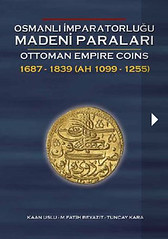 Our second book of the Ottoman Empire Coins Series has been published. In this book we cover the area from Suleyman-II to Mahmud-II (AH 1099-1255 / AD 1687-1839)
Our second book of the Ottoman Empire Coins Series has been published. In this book we cover the area from Suleyman-II to Mahmud-II (AH 1099-1255 / AD 1687-1839)
To see sample pages from our book please click the following link
issuu.com/kaanuslu/docs/ottoman_empire_coins_
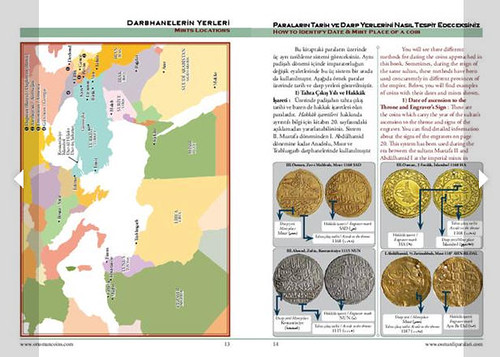
 You can either buy directly from EBAY using this link
http://cgi.ebay.com/ws/eBayISAPI.dll?ViewItem
You can either buy directly from EBAY using this link
http://cgi.ebay.com/ws/eBayISAPI.dll?ViewItem
&item=320629320036&ssPageName=STRK:MESELX:IT
or
You can send 60 US$ (registered postage cost included) directly to our Paypal address : kaan@uslu.net Our main web site (www.osmanliparalari.com) is fully renewed. It will be available in english very soon.
BOOK IN PROGRESS: COUNTERFEITER LYMAN PARKS (1788-1872)
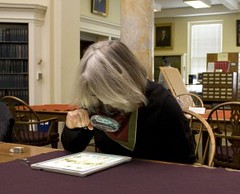 Deborah M. Child (www.deborahmchild.com) has been at AAS for the past month researching her upcoming book on Lyman Parks (1788-1872). Parks' forged bank notes were so accomplished that even the experts could not tell his notes from legitimate currency. Part of Fraud Week on Past is Present, Deborah's post below gives tips on how to identify counterfeit currency, starting with a bill that features our man-of-the-week, George Washington.
Deborah M. Child (www.deborahmchild.com) has been at AAS for the past month researching her upcoming book on Lyman Parks (1788-1872). Parks' forged bank notes were so accomplished that even the experts could not tell his notes from legitimate currency. Part of Fraud Week on Past is Present, Deborah's post below gives tips on how to identify counterfeit currency, starting with a bill that features our man-of-the-week, George Washington.
Gilbert Stuart's bust portrait of George Washington continues to be a favorite subject for vignettes on American currency. Shown here is an example from the AAS currency collection.

This counterfeit bank note is an excellent illustration of what to look for when examining currency made before 1862 when the Federal Government began regulating the currency. Prior to that, each bank adopted its own distinctive design. Paper was not standardized and bank note plates were outsourced to private engravers.
Internal control of currency was just as loosely maintained. Each note was individually numbered and then signed by the cashier and the bank president. Denominations for currency were not standardized either and could range from five and half cents to 10,000 dollars. All these variations provided a myriad of opportunities for the counterfeiters aka koniackers to ply their trade.
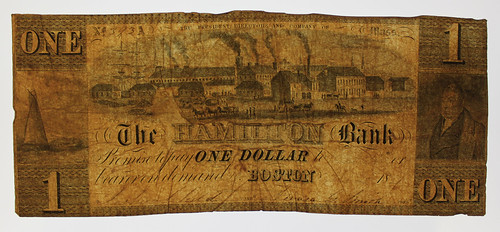
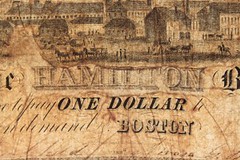 The second example is another bank note from the AAS currency collection. Examined over a light box, it becomes immediately apparent this bill has been chemically altered. The ink is uneven and the lettering is not consistent with the rest of the text. The paper is thinner and lighter, the texture altered, making it obvious that the bank name "Hamilton" in the center has been substituted.
The second example is another bank note from the AAS currency collection. Examined over a light box, it becomes immediately apparent this bill has been chemically altered. The ink is uneven and the lettering is not consistent with the rest of the text. The paper is thinner and lighter, the texture altered, making it obvious that the bank name "Hamilton" in the center has been substituted.
The bank for which it was originally printed was undoubtedly defunct so the counterfeiter removed the name of the original bank and substituted this name to place it back in circulation.
Not surprisingly, all this devious behavior corrupting the currency prompted a public outcry and a proliferation of anti-counterfeit guidebooks and newspapers. Trouble was the counterfeiters would study these guides as closely as the bankers and adjusted their practices accordingly.
To read the complete article, see:
Fraud Week, Part 3: Funny Money
(pastispresent.org/2011/good-sources/
fraud-week-part-3-funny-money/)
THE BOOK BAZARRE
MARGINALIA: DIM FUTURE FOR NOTES IN THE MARGINS
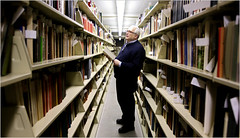 Locked in a climate-controlled vault at the Newberry Library here, a volume titled "The Pen and the Book" can be studied only under the watch of security cameras.
Locked in a climate-controlled vault at the Newberry Library here, a volume titled "The Pen and the Book" can be studied only under the watch of security cameras.
The book, about making a profit in publishing, scarcely qualifies as a literary masterpiece. It is highly valuable, instead, because a reader has scribbled in the margins of its pages.
The scribbler was Mark Twain, who had penciled, among other observations, a one-way argument with the author, Walter Besant, that "nothing could be stupider" than using advertising to sell books as if they were "essential goods" like "salt" or "tobacco." On another page, Twain made some snide remarks about the big sums being paid to another author of his era, Mary Baker Eddy, the founder of Christian Science.
Like many readers, Twain was engaging in marginalia, writing comments alongside passages and sometimes giving an author a piece of his mind. It is a rich literary pastime, sometimes regarded as a tool of literary archaeology, but it has an uncertain fate in a digitalized world.
"People will always find a way to annotate electronically," said G. Thomas Tanselle, a former vice president of the John Simon Guggenheim Memorial Foundation and an adjunct professor of English at Columbia University. "But there is the question of how it is going to be preserved. And that is a problem now facing collections libraries."
Marginalia was more common in the 1800s. Samuel Taylor Coleridge was a prolific margin writer, as were William Blake and Charles Darwin. In the 20th century it mostly came to be regarded like graffiti: something polite and respectful people did not do.
Paul F. Gehl, a curator at the Newberry, blamed generations of librarians and teachers for "inflicting us with the idea" that writing in books makes them "spoiled or damaged."
But marginalia never vanished. When Nelson Mandela was imprisoned in South Africa in 1977, a copy of Shakespeare was circulated among the inmates. Mandela wrote his name next to the passage from "Julius Caesar" that reads, "Cowards die many times before their deaths."
Studs Terkel, the oral historian, was known to admonish friends who would read his books but leave them free of markings. He told them that reading a book should not be a passive exercise, but rather a raucous conversation.
Books with markings are increasingly seen these days as more valuable, not just for a celebrity connection but also for what they reveal about the community of people associated with a work, according to Heather Jackson, a professor of English at the University of Toronto.
To read the complete article, see: Book Lovers Fear Dim Future for Notes in the Margins (www.nytimes.com/2011/02/21/books/21margin.html)
NUMISMATIC VOCABULARY: DAMASCENE
My local coin dealer and good friend, Dick Bacca (Heads & Tails Coin Shop, Torrington) sent me a scan this week. "Help identify this medal" he emailed.

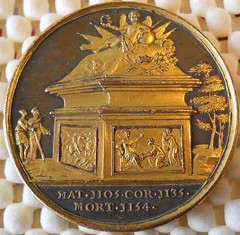
After some heavy researching the books I identified the medal from the Kings and Queens of England series, engraved by Jean Dassier. It is goldplating on a bronze medal, bears a portrait of King Stephen in full armor, with his vita in the reverse exergue: born 1105, crowned 1135, died 1154.
Digging deeper I found Chris Eimer's comments on this series in his book "British Commemorative Medals" (page 79). Chris stated "Bronze medals are occasionally found damascened, whereby the relief is gilt and the field "bronzed."
I vaguely remembered hearing the term damascene applied to medals before, but had never encountered an actual specimen. Here was an illustration in full color, and a documented use of the term "damascene."
In metalworking damascene means an inlay of gold usually in steel. In the medallic field it is an imitation of this by goldplating. Dassier's series was first struck in 1731 but the dies still existed into the following century when the medals were restruck -- 34 in all -- and finished with a heavy bronzing treatment. After which the medals were masked off where the gold was not to be deposited leaving the dark bronze finish intact, then goldplated. After the masking was removed the medal exhibited the dark brown field in stark contrast to the bright gold relief.
Since goldplating was not in active use until the 1840s, the restriking must have occurred after this time.(Before this time a gold surface was applied by firegilding with the use of mercury but the mercury fumes were poisonous, shortening the lives of such workers.) This piece was not firegilded, it was heavy goldplate.
With an example of damascene in front of me I realized I had not included the term in my "Encyclopedia of Coin and Medal Technology." Trouble is, I had just sent off the full manuscript to my associate at Medallic Art Company, Rob Vugteveen, which had clocked in at 1,851 terms. I could now write the entry on damascene and be able to illustrate it. Clock in entry number 1,852. Hey, the book is not printed yet, I can still add another term.
I am in my seventh decade in numismatics, 71 of my 80 years. This is a textbook case: You are never too old to learn something new!
THOMAS HIPSCHEN, BEP PORTRAIT ENGRAVER
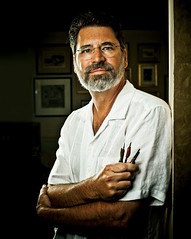 Though few Washingtonians know of him, most of us carry some of Thomas Hipschen's art every day. His portraits of Abraham Lincoln, Andrew Jackson, Ulysses S. Grant, and Ben Franklin are cut into American history, printed on the front of the $5, $20, $50, and $100 bills.
Though few Washingtonians know of him, most of us carry some of Thomas Hipschen's art every day. His portraits of Abraham Lincoln, Andrew Jackson, Ulysses S. Grant, and Ben Franklin are cut into American history, printed on the front of the $5, $20, $50, and $100 bills.
Hipschen is considered one of the world's best portrait engravers. "For the late 20th century, he is basically the engraver," says Mark D. Tomasko, author of The Feel of Steel, a history of currency engraving in the United States.
But when the Treasury Department rolls out a new $100 bill in February, the engraving on the front—a fuller portrait of Franklin—will be Hipschen's last. The two-centuries-old tradition of hand engraving is fading away. Bank-note artists who cut tiny dots, dashes, and lines into steel plates are putting down their tools and instead using a keyboard and a digital tablet to create images that can be produced in three weeks rather than three months.
The move to digital engraving has raised concern about security and even sparked conflict between the Federal Reserve, the central bank that buys the bank notes, and the Bureau of Engraving and Printing, which manufactures them, says Michael Lambert, assistant director for cash at the Federal Reserve Board.
Hand engraving has been a security feature of US currency since the early 1800s. Since then, it has been made increasingly complex and intricate in order to frustrate counterfeiters. Hand engraving has remained an important tool for fending off forgeries because engravers' artistic fingerprints—the subtle differences in style found in the tiny dots and dashes—are hard to replicate. Those idiosyncrasies get lost when the work is done on a computer.
A magnifying glass held to Benjamin Franklin's coat—which Hipschen lengthened for the new $100 bill—and to the facial and eye area on the left side of the note, reveals lines that are alternatively heavy, thin, dark, and light. Slanted, tic-tac-toe-like crosshatches with dots inside create depth and texture.
"It's almost as if the portrait is rising off the paper," says Gene Hessler, author of five books on paper money and engravers. "A master engraver like Hipschen creates this three-dimensional effect better than anyone."
Hipschen has spent decades studying engravings—especially those from the 1920s and '30s—to learn ways to use open space, lines, and dots. "There are a million little decisions because there are a million little dots," he says. "It's a very tiny canvas, so all the space has to be put to good use."
Hipschen's interest in art was sparked at age eight, when he saw a drawing of a young hare by the German Renaissance engraver Albrecht Dürer in a magazine. "I thought it was the most beautiful thing I had ever seen," he recalls. Hipschen also copied pictures in comic books that his father, a drugstore manager in Bellevue, Iowa, brought home after they didn't sell.
Hipschen dreamed of studying art in college but knew that with ten children in the family (he was second-oldest), his parents couldn't afford it. A door to art opened when his cousin Bob Jones, a postage-stamp designer at the Bureau of Engraving in DC, returned home to Iowa to visit and saw Hipschen's work. Jones knew the bureau was searching for an apprentice and encouraged his cousin to apply.
Hipschen traveled alone to Washington at age 17 with a bus ticket his grandfather had bought. He sketched a still life, competing with dozens of older artists before winning the post. He credits his youth with helping him get the job: "They wanted someone they could mold."
Over the 37 years Hipschen has spent at the Bureau of Engraving and Printing crouched over an angled, lighted table "digging ditches" in steel, often listening to Beethoven, the reproduction of engravings has evolved.
At first, the finished plates were hardened in molten cyanide and dipped in oil to cool, a technique used in the 1880s. That practice fell out of favor because it was too dangerous. In the 1980s and '90s, Hipschen continued cutting steel, but the engravings were photo-etched into metal and plastic. By 2000, he was practicing a hybrid engraving method, using both a burin and a computer.
Hipschen was the go-to guy for testing the digital technology. He agreed to put down his burin for a keyboard in 2000 and was sent to Lausanne, Switzerland, to learn to operate digital-engraving technology that could create three-dimensional portraits. Computer engraving involves generating lines, then using digital tools to warp, break, angle, taper, and widen them. When the image is complete, the computer runs a laser that cuts lines into plastic to create a metal plate.
After experimenting with the technology for a few weeks, Hipschen reluctantly declared it a viable option for making US currency. "Being able to artificially create depth was a great leap forward," he says. "It takes forever to do engraving by hand, but you can do this in minutes. It loses a lot of the character, but I had to admit it worked."
Repairing a damaged steel plate from an inadvertent slip can take a week, compared with slips in digital engraving, which can be repaired in seconds.
To read the complete article, see: Face Value (www.washingtonian.com/articles/people/17100.html)
MORE ON STEVE TANENBAUM
Jan Monroe writes:
I just wanted to say I knew Steve Tannebaum as a buyer for many years and though we were not close he was a gentleman and an expert at what ever item I bought from Indian Peace Medals to common tokens. It was always a chore to get his attention because so many were demanding his attention at once, the true mark of an expert. I am sorry for his untimely loss and best wishes to his loved ones.
Fred Holabird writes:
Steve, of all people, was kind enough to share important token stories with me over the years that helped me understand the distribution of western tokens from collections, and he was the source of much of the information I have written in our articles and catalogs, particularly the Moise story.
We shared a passion for tokens as the relics of American civilization, and the fact that we can actually put faces on the people that issued them. His wall of directories attested to the fact that he insisted on good research, and we had many discussions about this aspect of collecting. What a loss.
To read the earlier E-Sylum article, see: MORE ON DEALER STEVE TANENBAUM (www.coinbooks.org/esylum_v14n08a07.html)
THE BOOK BAZARRE
MORE ON WHO SAID STEPHEN NAGY WAS JOHN HASELTINE'S SON-IN-LAW?
Alan V. Weinberg writes:
Dave Hirt questioned the story that dealer Paul Seitz was Tom Elder's son-in-law.
On December 24, 1996 at 4 PM , sitting at my kitchen table, the late R.E. "Ted" Naftzger sold me a Gem Uncirculated 1793 Chain Ameri. cent that he'd acquired from Paul Seitz for $1,000 in 1946. It had not seen the light of day between 1946 and 1996 and was not ever shown or even mentioned to Dr. Wm. H. Sheldon (hence its absence from mention in Penny Whimsy) during his many visits and transactions with Ted - for a variety of reasons, some of which we can imagine.
During that Christmas Eve transaction, as I fondled the "raw" shimmering Chain cent, Ted told me that Paul Seitz was Tom Elder's son-in-law. Ted knew both Tom Elder and Paul Seitz. So that lends credence to the story that there was a relationship between the two.
To read the earlier E-Sylum article, see: MORE ON WHO SAID STEPHEN NAGY WAS JOHN HASELTINE'S SON-IN-LAW? (www.coinbooks.org/esylum_v14n08a13.html)
MORE ON THAT BEP INTAGLIO TEST PLATE
Joe Boling writes:
That block of four food stamps that Krause Publications used to illustrate their article on the BEP web press test plate is not related to that plate. That design was used decades ago - I've seen both blue and bistre versions (I believe there was a difference in the inscriptions). I don't know why they placed that illustration in the article on NumisMaster. Hopefully Neil's article in BNR will show the image in the plate that was sold.
Neil Shafer writes:
Thanks for including reference to my latest BNR article on the intaglio press that was at FUN. Your title for the coverage you provided was "An Intaglio Food Stamp Test Plate" and a picture of the orange 1939-43 food order stamps. Before I attended the FUN show I would have thought that the TEST NOTE pieces with Lincoln at left (one illustrated in the BNR article) were somehow related to the production or development of Food Coupons, but the point of the article came to be that such was absolutely Not the case. Instead it was a step towards the eventual production of the web press dollars made during the late 1980s and into the mid-1990s. The only reason I had put some food stamp background in the BNR article was just to fill in the historical context of the discussion. If I misguided anyone while discussing the Food Coupon history I am indeed sorry.
To read the earlier E-Sylum article, see: AN INTAGLIO FOOD STAMP TEST PLATE (www.coinbooks.org/esylum_v14n08a18.html)
BORDERS BANKRUPTCY - WHO GETS STIFFED?
Borders Group, Inc. and 7 associated debtors (the "Debtors" or "Borders") filed voluntary petitions under Chapter 11 of the Bankruptcy Code on February 16, 2011 in the Bankruptcy Court for the Southern District of New York (Case No. 11-10614). The Honorable Martin Glenn has been assigned to the case. This initial note provides the Debtors' consolidated list of their 30 largest unsecured creditors.
The Debtors' Consolidated List of Holders of Largest Unsecured Claims The Debtors' have requested authority to file a consolidated list of the holders of the Debtors' largest unsecured claims in lieu of a separate list for each of the Debtors. The consolidated list is set forth below.
To read the complete article, see:
Borders Group – 30 Largest Unsecured Creditors
(www.burbageweddell.com/2011/02/16/borders-group
-30-largest-unsecured-creditors/)
Howard A. Daniel III adds:
In the past, I have talked with two managers of Borders stores about books not being on their shelves, even when they are on the New York Times Best Seller List. So I was not surprised to read that Borders is in bankruptcy!
During one presidential campaign there was a book written by some veterans about one of the candidates. I know the authors and many of the contributors. It was a fact-checked book and I personally knew many of them to be true, but it was widely panned by those on one side of our political spectrum as a pack of lies. I bought several a week from several different bookstores and passed them out to people to read so they knew the truth about one of that candidates. I probably bought at least a hundred of them.
When I stopped at a Northern Virginia Borders to buy some copies, I could not find them on the shelf or on the New York Times table. I asked one of the clerks and they did not know why it was not available. I asked to speak to the manager. The manager told me she did not believe an untruthful book should be sold. I told her I knew it to be true and I would contact her corporate headquarters about her not stocking it.
I contacted the corporate headquarters and they told me none of their managers would not stock New York Times bestsellers or any other book as long as customers were buying them. I said that this manager (and later another store manager) did not stock all of them. A week later, I walked into the store. The book was not on the table but two of them were on the shelf. I bought the two and told the clerk I would be back the next day for two more. I never returned and have never gone into another Borders.
But I did go to a nearby Barnes and Noble and did not find their managers banning books from their stores. I continue to visit Barnes and Nobles and other bookstores when I want to see what has been recently published in my areas of interest, but you will never find me in a Borders.
QUERY: IS FLORESCENT LIGHTING HARMFUL TO BOOKS?
Mike Niebruegge writes:
NOTES FROM E-SYLUM READERS: FEBRUARY 27, 2011
Rhonda Kauffman, ANS Library Cataloguer
American Numismatic Society librarian Elizabeth Hahn writes:
We have recently taken on a new part-time cataloger here at the ANS Library (unfortunately our previous part-time cataloger left to pursue a full-time offer with another organization). Our new cataloger is Rhonda Kauffman, and she is already adjusting quite well to the numismatic world (and also has her own personal interest in U.S. coins!).
Prince Edward County
I read the article on the transfer of the Victoria Cross library to Ameliasburgh in Prince Edward County. Prince Edward County is not on Prince Edward Island, but is near Belleville, Ontario, a couple of thousand kilometers west of Prince Edward Island. The website gave some clues to this as it mentioned Quinte and Belleville. I thought that I should mention this just in case anyone is planning to drive up to see the library!
To read the earlier E-Sylum article, see: THE VICTORIA CROSS LIBRARY (www.coinbooks.org/esylum_v14n08a05.html)
On States and Hard Money
Joe Boling writes:
The South Carolina politician who wants hard money should probably wait until the impending trial of Bernard Von NotHaus (NORFED) concludes.
To read the earlier E-Sylum article, see: NOTES FROM E-SYLUM READERS: FEBRUARY 20, 2011: Another State Currency Proposal (www.coinbooks.org/esylum_v14n08a16.html)
More on the 1945 No Mintmark Nickels
Joe Boling adds:
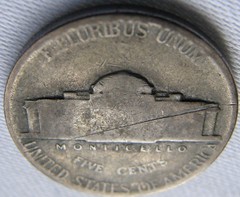 You may have the no-Mintmarks nickels paired up properly now, but you have the captions switched. And I believe I can also see a faint S over Monticello on the 1945 piece, in the straight-on shot. The angled shot looks more like a P, but there is definitely something there.
You may have the no-Mintmarks nickels paired up properly now, but you have the captions switched. And I believe I can also see a faint S over Monticello on the 1945 piece, in the straight-on shot. The angled shot looks more like a P, but there is definitely something there.
To read the earlier E-Sylum article, see: MORE ON 1945 NICKELS WITHOUT MINTMARKS (www.coinbooks.org/esylum_v14n08a10.html)
Ordering Sri Lankan Coins
Len Harsel writes:
Currency Department,
Central Bank of Sri Lanka,
30, Janadhipathi Mawatha,
Colombo 01. "
To read the earlier E-Sylum article, see: SRI LANKA ISSUES NEW BANKNOTES (www.coinbooks.org/esylum_v14n07a20.html)
Differences in Redbook Professional Editions
Mike Marotta writes:
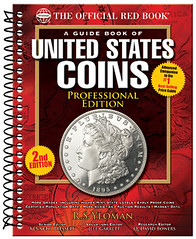 Bibliomaniacs may obsess over the differences between the first and second editions of A Guide Book of U.S. Coins: Professional Edition. "Appendix A: Countefeit Coins in Today's Market" (attributable to George DuBay), has been replaced with "Appendix: 2009-2010 Market Review, and Looking at 2011." "Appendix B: Gallery of Early U.S. Proof Coins" was removed and not replaced.
Bibliomaniacs may obsess over the differences between the first and second editions of A Guide Book of U.S. Coins: Professional Edition. "Appendix A: Countefeit Coins in Today's Market" (attributable to George DuBay), has been replaced with "Appendix: 2009-2010 Market Review, and Looking at 2011." "Appendix B: Gallery of Early U.S. Proof Coins" was removed and not replaced.
The list of contributors changed, which is to be expected, both in the narrative paragraph and the roster. Throughout the book, the column header "Auction Record" is now "Recent Auction Record." The colors of the design theme also are different. Those who know more about Federal Type coinage may identify changes that are more consequential.
ENGRAVING ON THE POINT OF A PIN
 We have often seen the Lord's Prayer engraved on such exonumia items as elongated cents and religious tokens. But an experiment in 1935 by an engraving machine company proved their machine could reduce that lettering on point of a pin! Notice I said the point of a pin -- not the head!
We have often seen the Lord's Prayer engraved on such exonumia items as elongated cents and religious tokens. But an experiment in 1935 by an engraving machine company proved their machine could reduce that lettering on point of a pin! Notice I said the point of a pin -- not the head!
The Groton Engraving Machine Corporation accomplished that feat of miniaturization in 1935. It was written about in an article published 1975 in the second issue of the Engravers Journal. They pulled up that classic article this week and put it on the internet.
To read the mammoth effort in Lilliputian activity click on: www.engraversjournal.com/article.php/14/index.html
In 1935 it was decided by the Groton Machine Corporation to attempt a dramatic demonstration of the extreme accuracy built into Groton machines which could be understood and appreciated by the non-technical as well as the technical mind. It is true that the 300 characters which make up the Lord's Prayer had been printed in characters so small that a magnifying glass was necessary in order to read them; they had been cut on a single slug of type and had also been engraved by hand on the head of a pin. But such work had never been successfully done by machine.
Below is their account of their attempt to do this same engraving on the point of a pin. The head of an average pin is approximately 100 thousandths of an inch (.100" or 1/10") in diameter. The point is approximately 5 thousandths of an inch in diameter (.005") or about twice the thickness of a human hair or one sheet of cigarette paper. This article tells the story of how this was done.
The first step was to engrave the Lord's Prayer in the correct design to fit into a circle and of a size which would be suitable for the proper reduction. This was done with the aid of standard Groton copy type. The resultant master or pattern was a 2" circle in which the Lord's Prayer had been engraved.
Then a Groton pantograph was taken from the production line and a few adjustments were made such as disassembling the machine and checking all ball bearings for size and roundness.
The object of this test was to reduce the master copy of the Lord's Prayer to as small an area as possible and still have it remain legible under a magnifier. The machine was set to reduce the original copy 400 times.
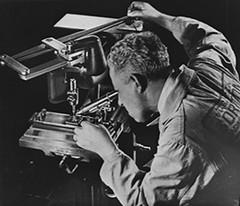
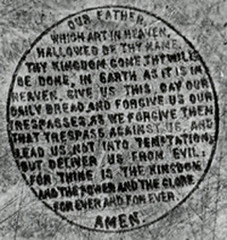
The engraving operation was performed by the very point of the cutter and difficulty was experienced in keeping an edge on the point until after numerous experiments, when a comparatively blunt bullet-shaped point was adopted. The next problem was that of polishing the surface to be engraved smooth and flat to within one hundred-thousandth of an inch. Many materials were used – different grades of rough, face powder, diamond-tine, etc., but finally it was found that polishing with a fine kid leather produced the finest surface. The kid seemed to have just enough dust embedded in it for proper polishing action.
The pantograph machine had to be insulated against vibrations set up in the shop floor. Although the machine was mounted on the concrete ground floor of their plant with wood block laid on top, the vibrations imparted from machines 100 feet away were sufficient to distort the engraving sufficiently to make it illegible. It was therefore necessary to use four rubber cushions 3" thick beneath the machine in order to eliminate this vibration.
The result of this experiment was the complete Lord's Prayer consisting of 300 characters engraved on the end of a platinum gold alloy wire within a circle of .005" in diameter.
The Lord's Prayer engraving described in this article is a permanent exhibit at the Lars Machine Inc. plant, and has been viewed by thousands of visitors from all parts of the world.
FOR INTERMEDIATE TO ADVANCED COLLECTORS. . . .
CHALLENGE COINS BECOME COPYCAT FAD AMONG BUREAUCRATS, POLITICIANS
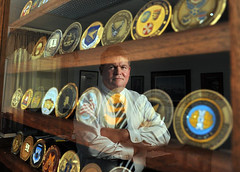 In the hospital, after her Black Hawk helicopter was shot down in a fireball, L. Tammy Duckworth's fellow soldiers made sure four of her personal items made the trip home from Iraq with her: her wedding ring, her dog tags, her unit patch and a coin she always kept in the breast pocket of her flight suit.
In the hospital, after her Black Hawk helicopter was shot down in a fireball, L. Tammy Duckworth's fellow soldiers made sure four of her personal items made the trip home from Iraq with her: her wedding ring, her dog tags, her unit patch and a coin she always kept in the breast pocket of her flight suit.
To an outsider, the coin might have seemed like little more than a curious, poker chip-size trinket, designed with the emblem of her Illinois National Guard unit. To Duckworth, now an assistant secretary of veterans affairs, it was sacred: "That's my identity."
"Challenge coins," as they are known, have become an important part of the ethos of the armed forces, where the story of service members' careers - deployments, promotions, awards - is told by the ribbons and patches on their uniforms. Traditionally, commanders hand out the coins to troops for exemplary service and morale boosting. That's how Duckworth got hers. That's why it meant so much.
But in recent years, many outside the military have adopted the tradition, turning a sacrosanct ritual, some say, into a form of military chic that is now part of the Washington power game. The coin craze extends into almost every nook of the federal government. The secretaries of education, transportation and agriculture have coins. So does the EPA administrator, and even the Department of Agriculture's Office of Information Technology.
The coins have gone global - the Australian ambassador has one. And corporate: Boeing has a coin. So does Starbucks.
This coin creep is to some in the military an off-putting act of plagiarism that sullies the tradition. To others, it's a flattering statement of solidarity with those who serve.
"I don't see it as an offense," said Navy Capt. John Kirby, spokesman for Adm. Mike Mullen, the Joint Chiefs of Staff chairman. "I look at it as them wanting to associate with the sacrifice that the military is making."
But others fear that the coins have become more about vanity - both the giver's and the receiver's - than about service and sacrifice.
"They've become like an autograph. It's a thing to say, 'I met this person,'" said Todd Bowers, who served two tours in Iraq and one in Afghanistan with the Marine Corps and is an official at Iraq and Afghanistan Veterans of America (yes, the nonprofit group has a coin). "Now they're business cards."
It is unclear how the coin tradition began, but the earliest one Jesse Medford, founder of the Challenge Coin Association, has ever seen was a 17th Infantry Division coin from the early 1950s. Special Forces units used them in the 1980s and the tradition slowly spread through the armed forces.
"It's been the last 10 years where it's spread like wildfire, definitely since the wars have been going on," he said.
In the past couple of years, the popularity of the coins has become "so vast that it's almost better to say who doesn't have a coin," said Adam Mulholland, owner of U.S. Challenge Coins, a Georgia manufacturer.
As the craze has taken off, the coins have gotten more elaborate - and expensive. McIntyre spent $6 a coin on his second batch, $7.50 on the next. The last batch cost $10 apiece, so he tried to be more discerning about whom he gave them to. But it had reached the point where it seemed everyone was handing out a coin.
"We're one step away from your neighbor giving you a coin for mowing the lawn," he joked.
The costs can add up. The office of the chairman of the Joint Chiefs of Staff spent $187,500 on 37,500 coins last year, according to a spokesman.
To read the complete article, see:
Military's prized 'challenge coins' become copycat fad among agencies, politicians, companies
(www.washingtonpost.com/wp-dyn/content
/article/2011/02/21/AR2011022104708.html)
To read the earlier E-Sylum, see: MOY'S "DIRECTOR'S COIN FOR EXCELLENCE" (www.coinbooks.org/esylum_v14n08a14.html)
MORE ON CHINESE COUNTERFEITS
Loren Gatch writes:
Although it's not a new issue, here's a recent article on Chinese counterfeits surfacing in Washington State. I came across the link in the latest issue of Coins Weekly (www.coinsweekly.com).
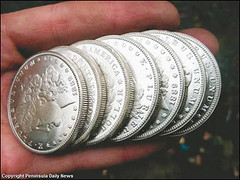 Counterfeit coins by the thousands are turning up in Washington state, and authorities are warning coin collectors to be on the lookout for them.
Counterfeit coins by the thousands are turning up in Washington state, and authorities are warning coin collectors to be on the lookout for them.
All or most of the counterfeits appear to be from China.
"Stacks of ingots, bars, all kinds of stuff - they make everything from pennies all the way up to silver dollars," says Port Angeles police officer Duane Benedict. "China is making these things by the thousands."
Several of the fake coins were recently sold to a Port Angeles business, EZ Pawn, for $400. They would have been worth more than $1,500 had they been real, Benedict said.
Officer Benedict got a call from EZ Pawn.
"They brought me in there to look at something they thought was fake. So I was pre-warned. But I picked it up and said, 'What's fake about it?'"
The 20 counterfeit U.S. Morgan silver dollars were supposedly from a century ago. Brian Winters of EZ Pawn has bought coins for years - and even he was fooled.
To read the complete article, see: Counterfeit coins from China turning up in Wash. state (www.komonews.com/news/local/115789384.html)
The House Financial Services committee has come up with a game plan for the next two years and a review of the fakes that are bedeviling the numismatic industry will be part of it.
Primarily though, the review will have an impact on activities of the U.S. Mint and the Bureau of Engraving and Printing.
The announcement came Feb. 10 as the full committee voted for a plan of action.
This examination will take place over the next two years during the 112th Congress in its first and second sessions. Democrats and Republicans jointly voted on the plan and, at least with respect to the Mint and BEP, the vote was not along party lines. That means that no specific date has been set for the fakes to come up for committee scrutiny.
The language regarding the fakes is governmentese at its best. In the words of the plan, it would review "efforts to detect and combat the counterfeiting of U.S. coins and currency in the United States and abroad," and in a first, they stated that they "will examine the counterfeiting of rare or investment-grade coins, U.S.-made and otherwise."
To read the complete article, see: Congress to Review Chinese Fakes (www.numismaster.com/ta/numis/Article.jsp?ad=article&ArticleId=18178)
THE BRITISH MUSEUM CELEBRATES ITS 150TH BIRTHDAY
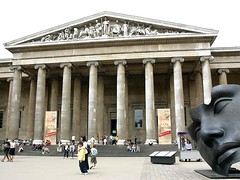 Here's an original article from Coins Weekly on the anniversary of the British Museum and its numismatic collection. It's nicely done and well illustrated - please check out the original in its entirety. Here are some excerpts. The image of the museum is from an earlier E-Sylum piece - the others are from the Coins Weekly article.
-Editor
Here's an original article from Coins Weekly on the anniversary of the British Museum and its numismatic collection. It's nicely done and well illustrated - please check out the original in its entirety. Here are some excerpts. The image of the museum is from an earlier E-Sylum piece - the others are from the Coins Weekly article.
-Editor
In 1861 the Department of Coins and Medals was separated from the Antiquity Department. Since then the BM coin cabinet is ranked among the biggest and most active numismatic research centers. On Friday, February 18, 2011 its 150th birthday was celebrated. A colloquium marked this special occasion.
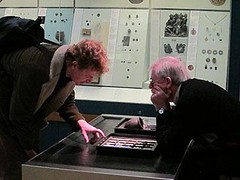 "Museums and the future of UK numismatics" – that was the title of this event. Lecturers mostly members of the British Museum staff described the position of the BM coin cabinet in the past and the present and outlined some ideas for the future.
"Museums and the future of UK numismatics" – that was the title of this event. Lecturers mostly members of the British Museum staff described the position of the BM coin cabinet in the past and the present and outlined some ideas for the future.
It goes without saying that the BM owned a nice coin collection of about 20.000 pieces, when it was founded in 1753. As "metal manuscripts" these numismatic objects formed part of the Department of Manuscripts, before they were affiliated to the Department of Antiquities in 1803. When the Department of Coins and Medals was founded in 1861, the museum owned already more than 157.000 numismatic pieces.
The real increase of the collection began at the end of the 19th century. Great Britain was the leading colonial power of that period. English officials formed coin collections all over the world and donated them to the British Museum. Today we only can estimate the inventory: About one million coins, medals, banknotes and other numismatic objects are fostered and interpreted in the Department of Coins and Medals.
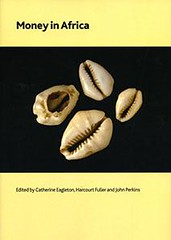 Today, 17 numismatists are in charge of the coin collection. With them the British Museum owns the world wide most numerous staff of numismatists. They can be proud of their predecessors who have published epochal books like the Catalogue of the Greek Coins in the British Museum, the Catalogue of the Oriental Coins or the RIC, the Roman Imperial Coinage.
Today, 17 numismatists are in charge of the coin collection. With them the British Museum owns the world wide most numerous staff of numismatists. They can be proud of their predecessors who have published epochal books like the Catalogue of the Greek Coins in the British Museum, the Catalogue of the Oriental Coins or the RIC, the Roman Imperial Coinage.
Then, publishing was the most important task of a curator. Today it is just one among many other duties.
To read the complete article, see: The British Museum celebrates its 150th birthday (www.coinsweekly.com/en/News/4?&id=460)
ANNAPOLIS PASTOR COLLECTS BIBLICAL COINS
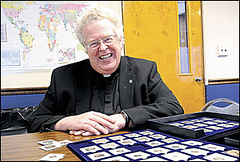 Jesus overturned the money changers' tables. For the past 15 years, the Rev. John Kingsbury has been cleaning up the mess.
Jesus overturned the money changers' tables. For the past 15 years, the Rev. John Kingsbury has been cleaning up the mess.
Kingsbury, pastor of St. Mary's Church in Annapolis, collects Biblical coins - a hobby that began when he wondered what kinds of currency were on the tables at the Jerusalem temple.
The question led him not to religious texts, because they lacked this sort of information, but to archaeological tomes. He started reading up on ancient coinage and decided he wanted 2,000 year-old examples to inspect. While many are quite valuable, the more common ones can be had for only a few dollars apiece, so the task wasn't out of the question.
"I've never met anybody like that before, especially in his profession," said Hank Schab of Annapolis, secretary of the Colonial Coin Club. "It's very interesting."
Kingsbury, who now blogs on the subject, gets the coins from dealers and at coin shows. He accumulates the most complete collection he can on a very limited budget.
His inventory mainly encompasses coins from 100 B.C. to 100 A.D., although he also has one of the oldest coins, a tiny 1/24 stater from Ionia in the 6th century B.C..
"He's got a nice collection and he knows a lot about them," said Brian Kritt, a Burtonsville coin dealer who has become friends with the pastor. "He's someone I respect and admire."
Kingsbury has more than 100 Roman, Greek and Judean pieces, neatly arranged in blue velvet cases and a book. Kingsbury isn't as much concerned with the condition of the coins as with the information they impart. He does appreciate the artistry of their designs, however.
The pastor often shows the coins to parishioners and uses them as teaching tools for students at St. Mary's. "He has a real flair," said Christine Kalkavage, who has Kingsbury visit her Latin classes. "And he has wonderful stories to tell about the coins. Students get to hold history in their hands."
Kingsbury admits it's an unusual hobby for a priest, but he said the coins have opened up a new side of scripture for him. "Different parables make sense when they didn't before," he said.
He's still keeping his eye out for more coins, but his current project is learning calligraphy so he can mimic the writing on them. One day, he wants to write a book about Biblical coins, and hopes to donate his collection to a Redemptorist museum.
Kingsbury said the coins have influenced how he approaches his calling.
"It's changed the way I preached. That's what I appreciate more than anything."
Kingsbury's blog can be found at biblicalcoins.wordpress.com .
To read the complete article, see:
Collecting a religious experience
(www.hometownannapolis.com/news/lif/2011/02/20-11
/Collecting-a-religious-experience.html)
FEATURED WEB SITE: BIBLICAL COINS BLOG
This week's Featured Web Site is Rev. John Kingsbury's Biblical Coins blog.
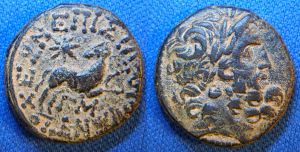
This blog concerns my interests in Biblical Coins and I take care of the Redemptorist Biblical Coin Collection. A small section of this collection is now on exhibit at the Charles Carroll House in Annapolis next to our Rectory (109 Duke of Gloucester). Charles Carroll was the only Roman Catholic signer of the Declaration of Independence and spoke in support of Religious Freedom as our country was being founded.
In this blog I will explore various ancient coins that are connected with the Christian Scriptures (mostly the Gospels). At times I also will make note of various books that will be helpful with this topic.
biblicalcoins.wordpress.com/
